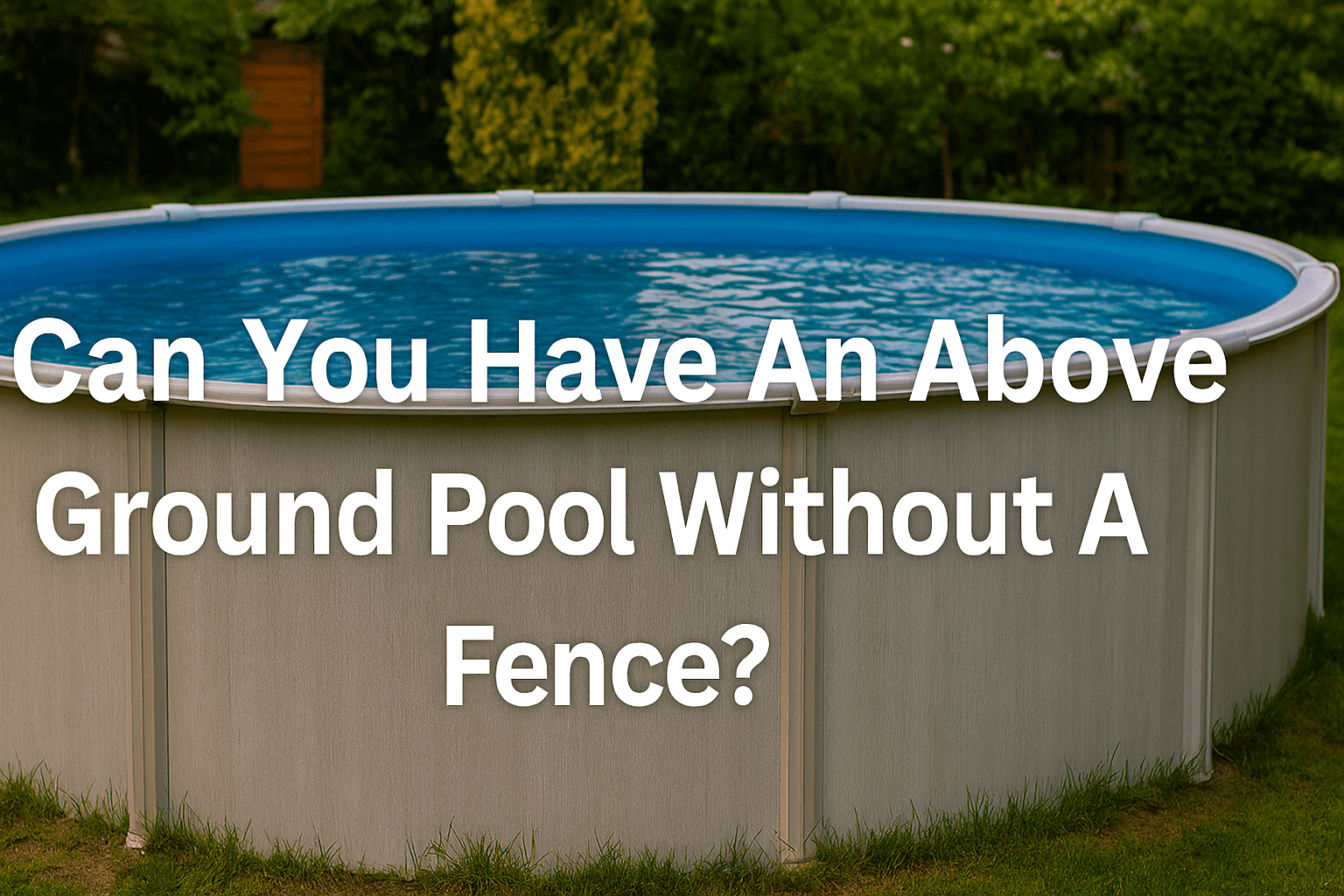
Can You Have An Above Ground Pool Without A Fence?
Dreaming of a garden pool without turning your backyard into Fort Knox? Short answer: yes, you can have an above ground pool without a fence—but it’s not always simple. Between UK rules, nosy neighbours, and splash-happy kids, there's more to consider. Keep reading for smart (and sneaky) safety tips!
As parents ourselves, we get the thrill of bringing home a garden pool. It’s not just about cooling off—it's about turning your outdoor space into a summer hub of joy. But excitement often comes with questions. Is it safe? Is it legal? And what happens if little feet find their way in unsupervised?
We're here to cut through the confusion and give you the straight facts—plus a few clever workarounds. Because every family deserves safe fun, minus the red tape.
Understanding Legal Requirements for Fencing
Varying State and Local Regulations (Jurisdictional Differences)
Fencing laws in the UK can feel like a patchwork quilt. What’s fine in one council area might raise eyebrows in another. That’s why it’s always worth a call to your local authority before you set anything up.
Rules aim to keep everyone safe, not spoil the fun. So even if there’s no national law saying you must install a fence, local rules might say otherwise.
Common Depth Thresholds for Requiring a Fence (e.g., 18 or 24 inches)
Depth matters. Most councils consider pools over 18 to 24 inches deep a safety risk—especially for kids who might wander in unsupervised.
If your above ground pool crosses that threshold, expect a few more rules to follow. And if it doesn’t? You might still want to play it safe with other safety measures.
Specific Fence Height Requirements (e.g., 48 inches, 5 feet)
If fencing is required, you’ll typically be looking at a minimum of 1.2 metres (about 48 inches). That’s tall enough to keep little climbers out and deter curious pets.
Materials matter too. Councils may specify non-climbable fencing—no handy footholds for little adventurers!
Gate Specifications (Self-Closing, Self-Latching, Latch Height)
Any gate accessing the pool area should close and latch by itself. Sounds simple, but it’s a big safety step.
The latch needs to be high—at least 1.5 metres up—so toddlers can’t reach it. It’s a small detail that can make a huge difference.

The "Pool Wall as a Barrier" Exception (When Permitted)
Conditions for Pool Structure to Serve as a Barrier
Here’s where it gets interesting: some above ground pools can act as their own fence.
If your pool walls are high enough—typically over 1.2 metres—and have smooth, non-climbable sides, you might be in luck. In some cases, that’s enough to meet safety rules.
Requirements for Ladders, Steps, and Decks
Of course, a tall pool means nothing if there’s a ladder sitting there all day. Removable or lockable ladders are essential.
Same goes for decks—any access point should be secure, with self-latching gates and barriers. Safety doesn’t stop at the edge.
Insurance and Liability Implications Without a Fence
Here’s the kicker: even if your council says a fence isn’t essential, your insurer might disagree.
Many UK home insurance policies require safety barriers for pools. If someone’s hurt and you didn’t have a fence, your cover might be affected—or worse, denied.
Some providers even offer lower premiums if you’ve got good safety measures in place. So it’s well worth checking the fine print.

The Critical Importance of a Pool Barrier for Safety
Preventing Accidental Drowning
Water looks fun—but it can turn dangerous in seconds. Drowning is silent, quick, and tragically common, especially for toddlers.
That’s why barriers are more than red tape. They’re literal lifesavers.
Safeguarding Children (Especially Toddlers)
Most kids see a pool and think: playtime. They don’t see the risks.
Without a fence or locked ladder, it only takes one moment of distraction. A ball bounces in, a toddler follows—and tragedy strikes.
Real stories like these are why we’re so passionate about pool safety. Supervision is vital, but barriers are your backup.
Protecting Pets and Wildlife
It’s not just kids—your curious Labrador or next-door neighbour’s cat could fall in too.
Even hedgehogs and foxes have been known to take an accidental dip. A barrier helps keep all creatures, big and small, out of harm’s way.
Deterring Unauthorised Access
Preventing Unsupervised Entry by Others
A pool’s tempting—especially to neighbourhood kids who see it as a secret splash zone.
Having a secure perimeter stops cheeky visitors from helping themselves. It protects them, and protects you.
Reducing "Attractive Nuisance" Risks
In legal terms, your pool can be seen as an "attractive nuisance"—something that’s inviting but dangerous.
If someone sneaks in and gets hurt, you could still be liable. A barrier helps reduce this risk, legally and practically.
Beyond Legal: Peace of Mind for Pool Owners
Rules aside, you want to relax in your garden—not constantly worry someone might wander into the water.
Knowing your pool is locked down tight lets you focus on what really matters: enjoying it.

Supplementary Safety Measures (When a Fence is Not Required or as Additional Protection)
Essential Safety Equipment and Practices
Pool Alarms (Surface, Sub-Surface, Door/Gate Alarms)
Tech to the rescue. Pool alarms can alert you the second someone touches the water or enters the area.
Some float on the surface, others go underwater, and some attach to gates or doors. Choose one that suits your setup—and test it regularly.
Safety Covers (Automatic, Manual, Mesh)
A quality pool cover can make all the difference. Automatic ones are convenient, but even manual or mesh versions add a layer of safety.
Just make sure it fits well and is strong enough to hold weight in case someone walks across it by accident.
Removable or Lockable Ladders/Steps
If you’re not fencing off the whole pool, removing the ladder is non-negotiable.
A lockable ladder or removable steps are simple tools that stop kids from climbing in uninvited.
Constant Supervision and Education
Never Leaving Children Unattended
Even with alarms and ladders locked away, you should never leave kids near the pool unsupervised.
It takes seconds for something to go wrong. So keep eyes—and ears—on them at all times.
Teaching Water Safety and CPR
Empower your kids. Teach them water rules early and practise how to float, call for help, or swim to the side.
Adults? It’s worth learning CPR. In a real emergency, that knowledge can save a life.
Maintaining a Secure Pool Environment
Keeping Furniture and Climbable Objects Away from Pool Edges
A garden chair may seem harmless—until a toddler drags it over and climbs in.
Keep the area clear of anything that could double as a step. Tables, pots, even toys.
Regular Checks of All Safety Features
Alarms fail. Ladders rust. Covers tear.
That’s why regular checks are a must. Walk around your pool every week to spot anything off and fix it fast.
Conclusion
Having an above ground pool without a fence? Totally doable. But it’s not just about skipping the wood and nails.
From council rules to childproofing, there’s a lot to think about. Luckily, there are loads of smart ways to stay safe without building a fortress.
Removable ladders, sturdy covers, and proper supervision all play a part. The key is making an informed choice—and sticking to it.
Because at the end of the day, your pool should bring joy, not stress. And a safe pool? That’s a happy one.
Have you checked out our other posts?
Do Above Ground Pools Need A Fence?
Do Above Ground Pools Need Planning Permission?
Do You Need A Permit For Above Ground Pools?


Leave a comment